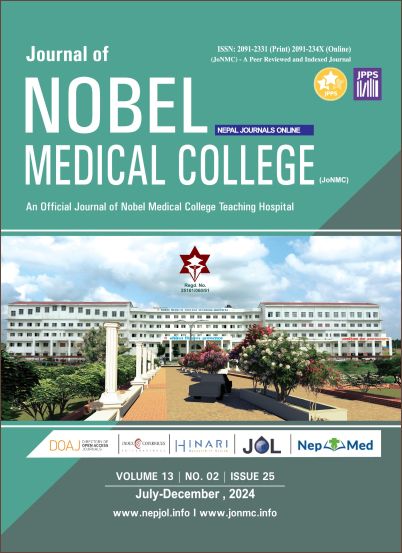Clinical Presentations and Outcome of Patients with Pleural Effusion: A Study at a Tertiary Care Center
DOI:
https://doi.org/10.3126/jonmc.v13i2.74399Keywords:
Pleura, Pleural effusion, Pneumonia, TuberculosisAbstract
Background: Pleural effusion is the collection of fluid in the pleural space. Divided into exudative and transudative type. This study aims to find the clinical profile, etiology, and outcome of the patients with pleural effusion.
Materials and Methods: This was a prospective descriptive study done in a tertiary center from 8th March 2024 to 7th September 2024. Ethical approval was taken from the institutional review committee (Ref:12/2024). A total of 60 adult patients with new onset pleural effusion were included in the study, with their demographics, clinical profile, and immediate outcome being studied.
Results: A total of 60 patients were included, the male-to-female ratio was 1.14: 1, with the mean age being 46.31 ± 9.62 years, with 32 (53.33%) patients of the age group 40-59 years. Tuberculosis was the most common etiology of pleural effusion occurring in 21 (35%) cases, followed by para-pneumonic effusion in 16 (26.67%) and congestive cardiac failure in 9 (15%). Shortness of breath was the most common symptom seen in 43 (71.67%) cases, while lymphocytosis was the most common hematological manifestation in 46(76.67%). The mean Adenosine Deaminase level was 67.21 ± 24.21 International Units /Litre. Two (3.33%) cases ended in mortality. The mean hospital stay was 8.86 ± 3.31 days. A rare occurrence of re-expansion pulmonary edema was observed.
Conclusion: The most common cause of pleural effusion in our setting is tuberculosis followed by para-pneumonic effusion, with 40-59 years of age being the most common age group. Adenosine deaminase level is a reliable indicator of tubercular pleural effusion.
Downloads
Downloads
Published
How to Cite
Issue
Section
License
Copyright (c) 2024 The Author(s)

This work is licensed under a Creative Commons Attribution 4.0 International License.
JoNMC applies the Creative Commons Attribution (CC BY) license to works we publish. Under this license, authors retain ownership of the copyright for their content, but they allow anyone to download, reuse, reprint, modify, distribute and/or copy the content as long as the original authors and source are cited.




